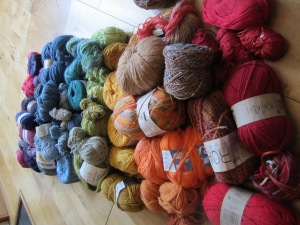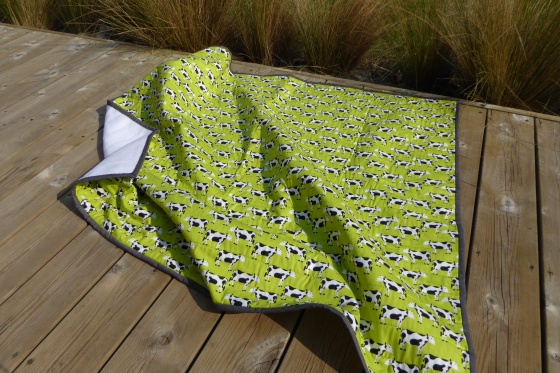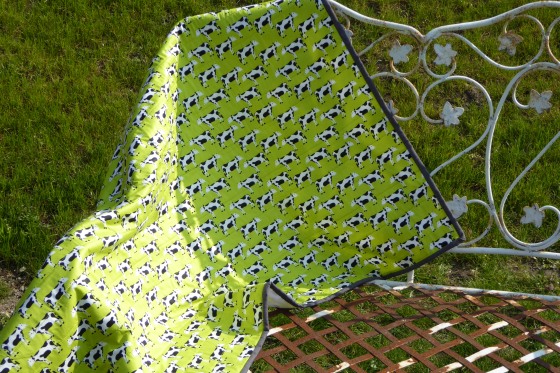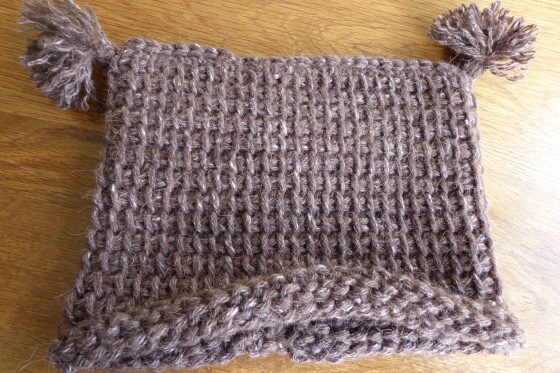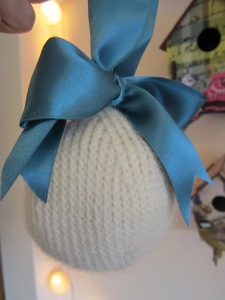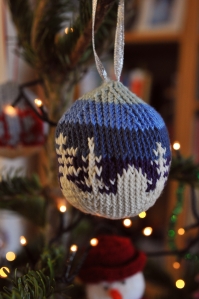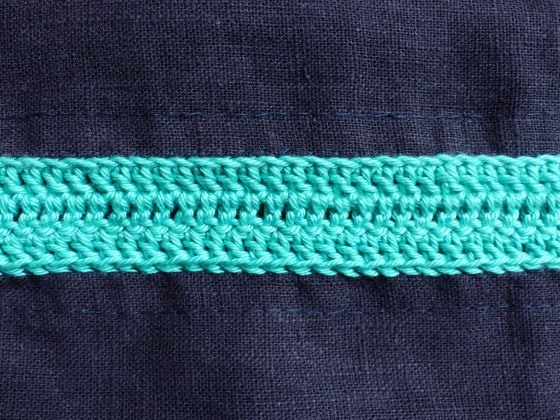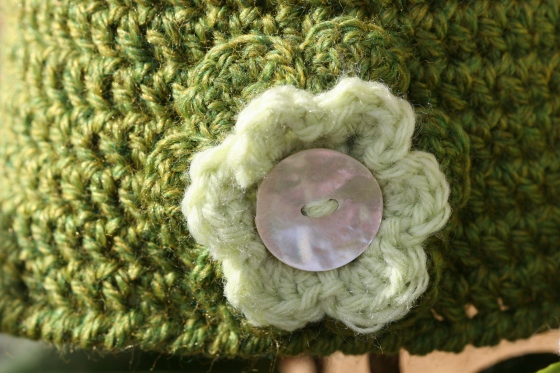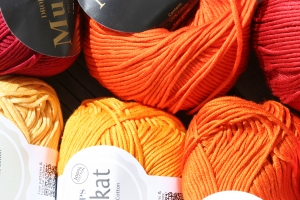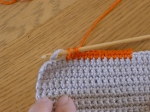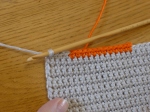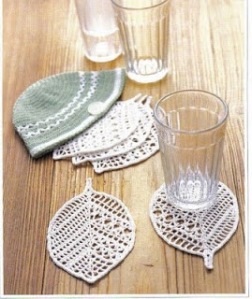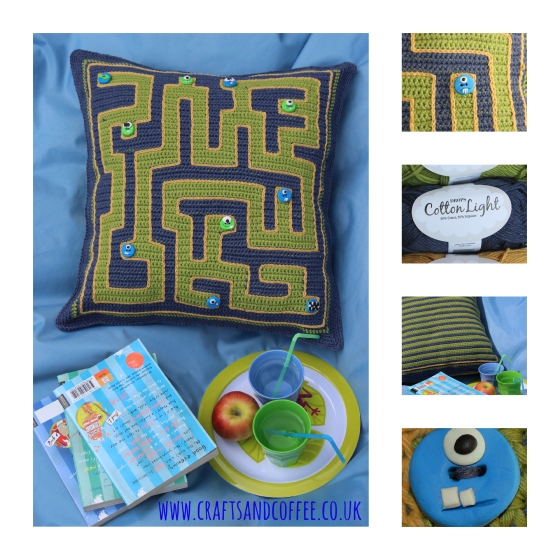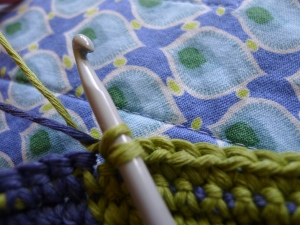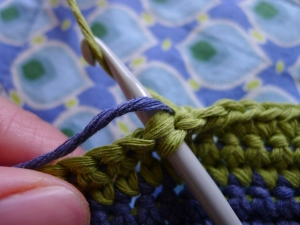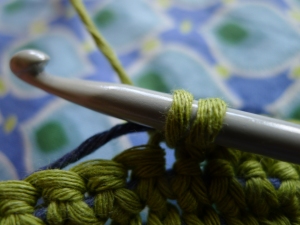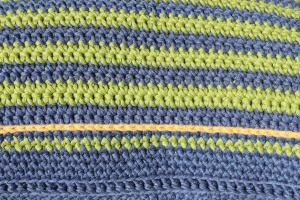

I love a trip to the seaside, and perhaps even more than Summer sunshine and ice cream trips, it’s the winter blow-away-the-cobwebs days I enjoy the most. It’s those kind of trips that have inspired this cushion – in my mind, it’s not tropical breaking waves, it’s good wintery, chilly English breaking waves on those precious days of the winter when the sun breaks through the clouds and the waves crash on the beach.
I’ve made this cushion using Rowan Felted Tweed, the colours are perfect for what I had in mind and as it’s 50% Merino Wool, 25% Alpaca and 25% Viscose it is a joy to work with.
I’d just like to say, as you’ll see if you scroll down this pattern has turned into a bit of an epic! I’ve made every effort to ensure that the instructions are correct and added diagrams and photos to help. However, if you do need any pattern support or clarification, just drop me a note (info@craftsandcofee.co.uk) and I’ll be happy to help!
To make this cushion you will need:
Rowan Felted Tweed
Seasalter (178) 50g
Scree (165) 150g
Maritime (167) 150g
Duck Egg (173) 150g
Clay (177) 50g
4mm Crochet Hook
7 Medium sized buttons
2mm clear glass beads (optional)
20 inch cushion pad
tapestry needle
This pattern is written using UK crochet terms.
Tension: On the cushion front horizontally from the peak of one wave to the next should be 8cm, and vertically 8cm is equal to 7 rows.
Cushion Front
The front of the cushion is a simple wave pattern made in treble crochet.

Starting in Scree (165) work 102 chain.
In 5th Chain from hook (the 4 chain count as one double treble) work 1 treble, then working along the chain work ,3 half treble, 4 double crochet, 3 half treble, 1 treble, 1 double treble.
Continue to work across the chain with the pattern *1 double treble, 1 treble, 3 half treble, 4 double crochet, 3 half treble, 1 treble, 1 double treble* repeat from * to * 5 more times.
Row A: 3 chain, turn work, and working in back loops only for the entire row work 1 treble in the back loop of the final double treble from the first row (effectively forming a 2 treble crochet increase). Then work 4 treble crochet, two 2 treble crochet decrease, 4 treble crochet, one 2 treble crochet increase.
Continue to work across the row with * one 2 treble crochet increase, 4 treble crochet, two 2 treble crochet decrease, 4 treble crochet, one 2 treble crochet increase* work from * to * 5 more times. Please note, the final 2 treble crochet increase will be worked into the back loop of the initial 4 chain. This is the right side of the work.
Row B: 3 chain, turn work, working in front loops only for the entire row work 1 treble in the back loop of the final double treble from the first row. Then work 4 treble crochet, two 2 Treble crochet decrease, 4 treble crochet, one 2 Treble Crochet increase.
Continue to work across the row with * one 2 treble crochet increase, 4 treble crochet, two 2 treble crochet decrease, 4 treble crochet, one 2 treble crochet increase* work from * to * 5 more times. This the back of the work.
Continue to work the cushion front following Rows A & B above – when the right side of the work is facing you, work in the back loops. When the back of the work is facing, work in the front loops.

The wave pattern is formed and on the right side of the work the front loops of each row are available for us to work the waves into later
The colours should be worked as follows:
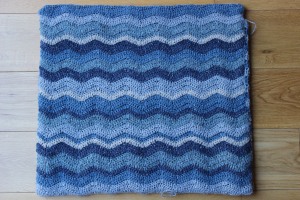
Here are the colours of the rows for the cushion front.
Bottom Row: Scree (165)
Row1: Scree (165)
Row 2: Scree (165)
Row 3: Maritime (167)
Row 4: Maritime (167)
Row 5: Seasalter (178)
Row 6: Duck Egg (173)
Row 7: Duck Egg (173)
Row 8: Duck Egg (173)
Row 9: Seasalter (178)
Row 10: Seasalter (178)
Row 11: Clay (177)
Row 12: Maritime (167)
Row 13: Scree (165)
Row 14: Scree (165)
Row 15: Duck Egg (173)
Row 16: Duck Egg (173)
Row 17: Seasalter (178)
Row 18: Maritime (167)
Row 19: Maritime (167)
Row 20: Maritime (167)
Row 21: Clay (177)
Row 22: Scree (165)
Row 23: Scree (165)
Row 24: Scree (165)
Row 25: Seasalter (178)
Row 26: Seasalter (178)
Row 27: Duck Egg (173)
Row 28: Duck Egg (173)
Row 29: Maritime (167)
Row 30: Maritime (167)
Row 31: Seasalter (178)
Row 32: Seasalter (178)
Row 33: Clay (177)
Row 34: Duck Egg (173)
Row 35: Duck Egg (173)
Row 36: Duck Egg (173)
Row 37: Scree (165)
Row 38: Scree (165)
Row 39: Maritime (167)
Row 40: Maritime (167)
Top Row: Maritime (167)
Normally I wouldn’t go so far in a pattern like this to suggest row by row which colours you should use. However, as the Rowan yarn is quite expensive (and therefore if you’re like me you might not want to buy an extra ball if you run out!) if you follow the rows as above and your tension is the same as mine (detailed above) you’ll have enough yarn left of each colour to work the detailing on the front of the cushion.
Once you have worked 40 rows of waves, using Maritime (167), 1 chain (does not count as first double crochet) and turn work. Work back across the row *2 double crochet, 3 half treble, 1 treble, 2 double treble, 1 treble, 3 half treble, 2 double crochet* repeat from * to * 6 more times. Cut yarn and fasten off.

You will now have a square of waves onto which we’re going to work the detail of the raised waves from the top down as follows:
On some of these raised waves I’ve chosen to work a few clear glass beads – this is optional, so I’ll mention which rows I use them on and you can decide what you’d like to do. If you do decide to use beads, thread them onto the yarn before starting the row and then use them as you work across the row. They look best if placed randomly, so just decide for yourself how you’d like to place them.
Wave 1 (worked into the loops between the top row and row 40) Scree (165): Thread on 17 beads, attach yarn and 1 chain, work 1 double crochet into each of the loops across the cushion front.
Wave 2 (worked into the loops between row 40 and row 39) Duck Egg (173): Attach yarn, 1 chain, 1 double crochet into each of the loops across the cushion front.
Wave 3 (worked into the loops between row 39 and row 38) Seasalter (178): Attach yarn, 1 chain, 1 double crochet into each of the loops across the cushion front.
Now to make the raised waves slightly more ‘textured’ we’re going to start adding an increase (so, work two stitches into one of the loops) at the top and bottom of each wave.
Wave 4 (worked into the loops between row 38 and row 37) Maritime (167): Attach yarn, 1 chain, work across the row in double crochet, adding one 2DC Inc (so place two double crochet into one loop) at the top and bottom of each wave.
Wave 5 (worked into the loops between row 37 and row 36) Seasalter (178): Attach yarn, 1 chain, work across the row in double crochet, adding one 2DC Inc (so place two double crochet into one loop) at the top and bottom of each wave.
Wave 6 (worked into the loops between row 36 and row 35) Clay (177): Attach yarn, 1 chain, work across the row in double crochet, adding one increase (so place two double crochet into one loop) at the top and bottom of each wave.
Wave 7 (worked into the loops between row 35 and row 34) Scree (165): Attach yarn, 2 chain, work across the row in half trebles, adding one increase (so place two half treble crochet into one loop) at the top and bottom of each wave.
Wave 8 (worked into the loops between row 34 and row 33) Duck Egg (173): Add beads to this wave. Attach yarn, 1 chain, work across the row in double crochet, adding one 2DC Inc (so place two double crochet into one loop) at the top and bottom of each wave.
Wave 9 (worked into the loops between row 33 and row 32) Maritime (167): Attach yarn, 2 chain, work across the row in half trebles, adding one 2 1/2 Trble increase (so place two half treble crochet into one loop) at the top and bottom of each wave.
Wave 10 (worked into the loops between row 32 and row 31) Duck Egg (173): Attach yarn, 1 chain, work across the row in double crochet, adding one 2DC Inc (so place two double crochet into one loop) at the top and bottom of each wave.
Wave 11 (worked into the loops between row 31 and row 30) Clay (177): Attach yarn, 2 chain, work across the row in half trebles, adding one 2 1/2 Trble increase (so place two half treble crochet into one loop) at the top and bottom of each wave.
Wave 12 (worked into the loops between row 30 and row 29) Seasalter (178): Add beads to this wave. Attach yarn, 1 chain, work across the row in double crochet, adding one 2DC Inc (so place two double crochet into one loop) at the top and bottom of each wave.
Wave 13 (worked into the loops between row 29 and row 28) Scree (165): Attach yarn, 2 chain, work across the row in half trebles, adding one 1/2 Trble increase (so place two half treble crochet into one loop) at the top and bottom of each wave.
Wave 14 (worked into the loops between row 28 and row 27) Maritime (167): Attach yarn, 1 chain, work across the row in double crochet, adding one 2DC Inc (so place two double crochet into one loop) at the top and bottom of each wave.
Now, to make the raised waves more pronounced, you will add two increases at the top and bottom of each wave. So, for example if the wave is worked in double crochet, you’ll add 2DC Inc twice at the top and bottom of each wave.
Wave 15 (worked into the loops between row 27 and row 26) Clay (177): Attach yarn, 1 chain, work across the row in double crochet, adding 2 increases at the top and bottom of each wave.
Wave 16 (worked into the loops between row 26 and row 25) Duck Egg (173) Attach yarn, 2 chain, work across the row in half treble crochet, adding 2 increases at the top and bottom of each wave.
Wave 17 (worked into the loops between row 25 and row 24) Maritime (167) Attach yarn 3 chain, work across the row in treble crochet, adding 2 increases at the top and bottom of each wave.
Wave 18(worked into the loops between row 24 and row 23) SeaSalter (178) Attach yarn, 2 chain, work across the row in half treble crochet, adding 2 increases at the top and bottom of each wave.
Wave 19 (worked into the loops between row 23 and row 22) Duck Egg (173) Attach yarn, 1 chain, work across the row in double crochet, adding 2 increases at the top and bottom of each wave.
Wave 20 (worked into the loops between row 22 and row 21) Maritime (167) Attach yarn, 2 chain, work across the row in half treble crochet, adding 2 increases at the top and bottom of each wave.
Wave 21 (worked into the loops between row 21 and row 20) Clay (177) Attach yarn 3 chain, work across the row in treble crochet, adding 2 increases at the top and bottom of each wave.
Wave 22 (worked into the loops between row 20 and row 19) Scree (165) Add beads on this wave. Attach yarn, 2 chain, work across the row in half treble crochet, adding 2 increases at the top and bottom of each wave.
Wave 23 (worked into the loops between row 19 and row 18) Seasalter (178) Attach yarn, 1 chain, work across the row in double crochet, adding 2 increases at the top and bottom of each wave.
Wave 24(worked into the loops between row 18 and row 17) Duck Egg (173) Attach yarn, 2 chain, work across the row in half treble crochet, adding 2 increases at the top and bottom of each wave.
Wave 25(worked into the loops between row 1 7 and row 16) Maritime (167) Attach yarn 3 chain, work across the row in treble crochet, adding 2 increases at the top and bottom of each wave.
Wave 26(worked into the loops between row 16 and row 15) Seasalter (178) Attach yarn, 2 chain, work across the row in half treble crochet, adding 2 increases at the top and bottom of each wave.
Wave 27 (worked into the loops between row 15 and row 14) Clay (177)Attach yarn, 1 chain, work across the row in double crochet, adding 2 increases at the top and bottom of each wave.
Wave 28 (worked into the loops between row 14 and row 13) Duck Egg (173) Attach yarn, 2 chain, work across the row in half treble crochet, adding 2 increases at the top and bottom of each wave.
Now we’re going to add the breaking waves. This can sound a little tricky, but all you’re going to be doing is working across the waves in double crochet including the increases at the top and bottom of each wave as you have been doing above. Into these waves of double crochet we’ll be adding swirls to create the breaking waves.
There are two different positions along the waves that we’re going to add the swirls that create the breaking waves.
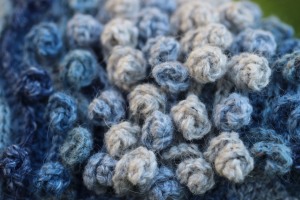
Position 1 is adding a wave in the middle of the straight side of each wave (i.e. between the top and bottom of each wave) as indicated by the ‘1’ in the diagram below.
Position 2 is adding a wave at the top and bottom of each wave, between the increase stitches (i.e. at the top and bottom of each wave) as indicated by the ‘2’ in the diagram below.

Add the spirals in the positions indicated above.
5 Chain swirl: 5 chain, 3DC into 2nd chain from hook, 3 DC into each of the remaining 3 chain.
6 Chain swirl: 6 chain, 3DC into 2nd chain from hook, 3 DC into each of the remaining 4 chain.
8 Chain swirl: 8 chain, 3DC into 2nd chain from hook, 3DC into each of the remaining 6 chain.
Wave 29 (worked into the loops between row 13 and row 12) Seasalter (178) Attach yarn, 1 chain, work across the row in double crochet, adding 2 increases at the top and bottom of each wave, add one 5 chain swirl in each position 1.
Wave 30 (worked into the loops between row 12 and row 11) Maritime (167) Attach yarn, 1 chain, work across the row in double crochet, adding 2 increases at the top and bottom of each wave, add one 5 chain swirl in each position 2.
Wave 31 (worked into the loops between row 11 and row 10) Duck Egg (173) Attach yarn, 1 chain, work across the row in double crochet, adding 2 increases at the top and bottom of each wave, add one 5 chain swirl in each position 1.
Wave 32 (worked into the loops between row 10 and row 9) Scree (165) Attach yarn, 1 chain, work across the row in double crochet, adding 2 increases at the top and bottom of each wave, add one 6 chain swirl in each position 2.
Wave 33 (worked into the loops between row 9 and row 8) Clay (177)Attach yarn, 1 chain, work across the row in double crochet, adding 2 increases at the top and bottom of each wave, add one 6 chain swirl in each position 1 & 2.
Wave 34 (worked into the loops between row 8 and row 7) Scree (165)Attach yarn, 1 chain, work across the row in double crochet, adding 2 increases at the top and bottom of each wave, add one 6 chain swirl in each position 1 & 2.
Wave 35 (worked into the loops between row 7 and row 6) Clay (177)Attach yarn, 1 chain, work across the row in double crochet, adding 2 increases at the top and bottom of each wave, add one 8 chain swirl in each position 1 & 2.
Wave 36 (worked into the loops between row 6 and row 5) Clay (177)Attach yarn, 1 chain, work across the row in double crochet, adding 2 increases at the top and bottom of each wave, add one 8 chain swirl in each position 1 & 2.
Wave 37 (worked into the loops between row 5 and row 4) Scree (165)Attach yarn, 1 chain, work across the row in double crochet, adding 2 increases at the top and bottom of each wave, add one 6 chain swirl in each position 1.
Wave 38 (worked into the loops between row 4 and row 3) Duck Egg (173)Attach yarn, 1 chain, work across the row in double crochet, adding 2 increases at the top and bottom of each wave, add one 6 chain swirl in each position 2.
Wave 39 (worked into the loops between row 3 and row 2) Maritime (167)Attach yarn, 1 chain, work across the row in double crochet, adding 2 increases at the top and bottom of each wave, add one 5 chain swirl in each position 1.
Wave 40 (worked into the loops between row 2 and row 1) Seasalter (178)Attach yarn, 1 chain, work across the row in double crochet, adding 2 increases at the top and bottom of each wave, add one 5 chain swirl in each position 2.
Cushion Back
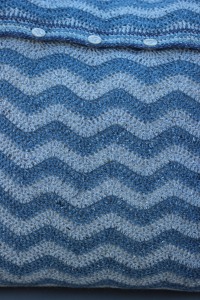
The cushion back is worked in waves of Scree (165) and Maritime (167)
Starting in Scree (165) work 102 chain.
In 5th Chain from hook (the 4 chain count as your first double treble) work 1 treble, then working along the chain work 3 half treble, 4 double crochet, 3 half treble, 1 treble, 1 double treble.
Continue to work across the chain with the pattern *1 double treble, 1 treble, 3 half treble, 4 double crochet, 3 half treble, 1 treble, 1 double treble* repeat from * to * 5 more times.
3 chain, turn work, 1 treble into same stitch, then work 4 treble crochet, two 2 treble crochet decrease, 4 treble crochet, one 2 treble crochet increase.
Continue to work across the row with * one 2 treble crochet increase, 4 treble crochet, two 2 treble crochet decrease, 4 treble crochet, one 2 treble crochet increase* work from * to * 5 more times. Please note that the last 2 treble crochet increase will be worked into the 4th of the initial 4 chain.
Change to Maritime (167)
3 chain, turn work, 1 treble in the same stitch, then work 4 treble crochet, two 2 treble crochet decrease, 4 treble crochet, one 2 treble crochet increase.
Continue to work across the row with * one 2 treble crochet increase, 4 treble crochet, two 2 treble crochet decrease, 4 treble crochet, one 2 treble crochet increase* work from * to * 5 more times. This the back of the work.
Work up the back of the cushion, with 2 rows of each colour until you have 41 rows and keeping the Scree (165) yarn attached work:
1 chain (does not count as first double crochet) and turn work. Work back across the row *2 double crochet, 3 half treble, 1 treble, 2 double treble, 1 treble, 3 half treble, 2 double crochet* repeat from * to * 6 more times. Cut yarn and fasten off.
Next you’ll need to make the button band. The band is worked in stripes of double crochet using up scrap yarn from the front of the cushion – so use up your scraps, working 1 row in each colour.

Work 101 chain. 1 DC in 2nd Chain from hook, work 1 DC in each chain.
1 chain, turn.
Change colour, 1 DC into each DC from the previous row, 1 chain, turn.
Change colour, 1 DC into each DC from the previous row, 1 chain, turn.
Now to make the button holes:
6DC, 3 chain, skip 3DC, *11 DC, 3 chain, skip 3DC* repeat from * to * 5 more times, 5dc, 1 chain, turn.
Change colour, 1 DC into each DC from the previous row. Each time you come to a button hole, work 3 DC into the 3 chain space, 1 chain, turn.
Change colour, 1 DC into each DC from the previous row, 1 chain, turn.
Change colour, 1 DC into each DC from the previous row, 1 chain, turn.
Change colour to Scree (165)
4 chain (counts as your first double treble), 1 treble, then working along the chain work 3 half treble, 4 double crochet, 3 half treble, 1 treble, 1 double treble.
Continue to work across the chain with the pattern *1 double treble, 1 treble, 3 half treble, 4 double crochet, 3 half treble, 1 treble, 1 double treble* repeat from * to * 5 more times.
Continue to work 2 rows of waves in Maritime, 2 in Scree, 2 in maritime and then the final row in Scree should be worked as follows:
1 chain, turn, work back across the row *2 double crochet, 3 half treble, 1 treble, 2 double treble, 1 treble, 3 half treble, 2 double crochet* repeat from * to * 6 more times. Cut yarn and fasten off.
Making the Cushion
Sew in all loose ends of yarn (this can take some time – settle down with a cup of tea and turn on the radio!)
Lay the main part of the cushion back onto the wrong side of the cushion front and stitch down the sides and across the base.
Lay the smaller part of the cushion back onto the wrong side of the cushion front (so that the button band overlaps with the main part of the cushion back). Stitch the two short sides and across the top.
Stitch on the buttons so that they correspond with the button holes.
Add the cushion pad and you’re done!


